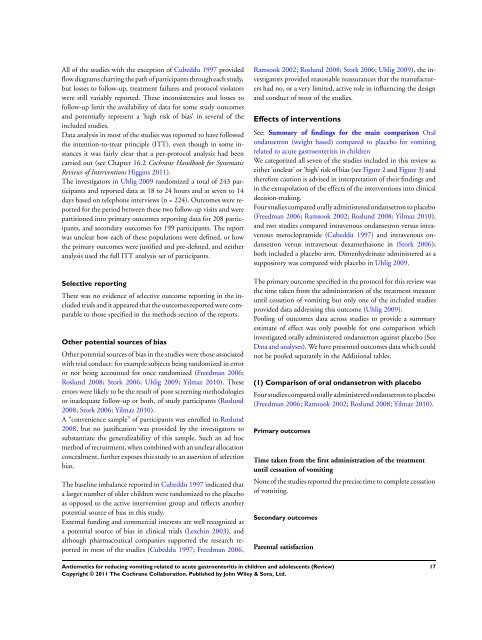Antiemetics for reducing vomiting related to acute ... - Update Software
Antiemetics for reducing vomiting related to acute ... - Update Software
Antiemetics for reducing vomiting related to acute ... - Update Software
You also want an ePaper? Increase the reach of your titles
YUMPU automatically turns print PDFs into web optimized ePapers that Google loves.
All of the studies with the exception of Cubeddu 1997 provided<br />
flow diagrams charting the path of participants through each study,<br />
but losses <strong>to</strong> follow-up, treatment failures and pro<strong>to</strong>col viola<strong>to</strong>rs<br />
were still variably reported. These inconsistencies and losses <strong>to</strong><br />
follow-up limit the availability of data <strong>for</strong> some study outcomes<br />
and potentially represent a ’high risk of bias’ in several of the<br />
included studies.<br />
Data analysis in most of the studies was reported <strong>to</strong> have followed<br />
the intention-<strong>to</strong>-treat principle (ITT), even though in some instances<br />
it was fairly clear that a per-pro<strong>to</strong>col analysis had been<br />
carried out (see Chapter 16.2 Cochrane Handbook <strong>for</strong> Systematic<br />
Reviews of Interventions Higgins 2011).<br />
The investiga<strong>to</strong>rs in Uhlig 2009 randomized a <strong>to</strong>tal of 243 participants<br />
and reported data at 18 <strong>to</strong> 24 hours and at seven <strong>to</strong> 14<br />
days based on telephone interviews (n = 224). Outcomes were reported<br />
<strong>for</strong> the period between these two follow-up visits and were<br />
partitioned in<strong>to</strong> primary outcomes reporting data <strong>for</strong> 208 participants,<br />
and secondary outcomes <strong>for</strong> 199 participants. The report<br />
was unclear how each of these populations were defined, or how<br />
the primary outcomes were justified and pre-defined, and neither<br />
analysis used the full ITT analysis set of participants.<br />
Selective reporting<br />
There was no evidence of selective outcome reporting in the included<br />
trials and it appeared that the outcomes reported were comparable<br />
<strong>to</strong> those specified in the methods section of the reports.<br />
Other potential sources of bias<br />
Other potential sources of bias in the studies were those associated<br />
with trial conduct: <strong>for</strong> example subjects being randomized in error<br />
or not being accounted <strong>for</strong> once randomized (Freedman 2006;<br />
Roslund 2008; S<strong>to</strong>rk 2006; Uhlig 2009; Yilmaz 2010). These<br />
errors were likely <strong>to</strong> be the result of poor screening methodologies<br />
or inadequate follow-up or both, of study participants (Roslund<br />
2008; S<strong>to</strong>rk 2006; Yilmaz 2010).<br />
A “convenience sample” of participants was enrolled in Roslund<br />
2008, but no justification was provided by the investiga<strong>to</strong>rs <strong>to</strong><br />
substantiate the generalizability of this sample. Such an ad hoc<br />
method of recruitment, when combined with an unclear allocation<br />
concealment, further exposes this study <strong>to</strong> an assertion of selection<br />
bias.<br />
The baseline imbalance reported in Cubeddu 1997 indicated that<br />
a larger number of older children were randomized <strong>to</strong> the placebo<br />
as opposed <strong>to</strong> the active intervention group and reflects another<br />
potential source of bias in this study.<br />
External funding and commercial interests are well recognized as<br />
a potential source of bias in clinical trials (Lexchin 2003), and<br />
although pharmaceutical companies supported the research reported<br />
in most of the studies (Cubeddu 1997; Freedman 2006,<br />
Ramsook 2002; Roslund 2008; S<strong>to</strong>rk 2006; Uhlig 2009), the investiga<strong>to</strong>rs<br />
provided reasonable reassurances that the manufacturers<br />
had no, or a very limited, active role in influencing the design<br />
and conduct of most of the studies.<br />
Effects of interventions<br />
See: Summary of findings <strong>for</strong> the main comparison Oral<br />
ondansetron (weight based) compared <strong>to</strong> placebo <strong>for</strong> <strong>vomiting</strong><br />
<strong>related</strong> <strong>to</strong> <strong>acute</strong> gastroenteritis in children<br />
We categorized all seven of the studies included in this review as<br />
either ’unclear’ or ’high’ risk of bias (see Figure 2 and Figure 3) and<br />
there<strong>for</strong>e caution is advised in interpretation of their findings and<br />
in the extrapolation of the effects of the interventions in<strong>to</strong> clinical<br />
decision-making.<br />
Four studies compared orally administered ondansetron <strong>to</strong> placebo<br />
(Freedman 2006; Ramsook 2002; Roslund 2008; Yilmaz 2010),<br />
and two studies compared intravenous ondansetron versus intravenous<br />
me<strong>to</strong>clopramide (Cubeddu 1997) and intravenous ondansetron<br />
versus intravenous dexamethasone in (S<strong>to</strong>rk 2006);<br />
both included a placebo arm. Dimenhydrinate administered as a<br />
supposi<strong>to</strong>ry was compared with placebo in Uhlig 2009.<br />
The primary outcome specified in the pro<strong>to</strong>col <strong>for</strong> this review was<br />
the time taken from the administration of the treatment measure<br />
until cessation of <strong>vomiting</strong> but only one of the included studies<br />
provided data addressing this outcome (Uhlig 2009).<br />
Pooling of outcomes data across studies <strong>to</strong> provide a summary<br />
estimate of effect was only possible <strong>for</strong> one comparison which<br />
investigated orally administered ondansetron against placebo (See<br />
Data and analyses). We have presented outcomes data which could<br />
not be pooled separately in the Additional tables.<br />
(1) Comparison of oral ondansetron with placebo<br />
Four studies compared orally administered ondansetron <strong>to</strong> placebo<br />
(Freedman 2006; Ramsook 2002; Roslund 2008; Yilmaz 2010).<br />
Primary outcomes<br />
Time taken from the first administration of the treatment<br />
until cessation of <strong>vomiting</strong><br />
None of the studies reported the precise time <strong>to</strong> complete cessation<br />
of <strong>vomiting</strong>.<br />
Secondary outcomes<br />
Parental satisfaction<br />
<strong>Antiemetics</strong> <strong>for</strong> <strong>reducing</strong> <strong>vomiting</strong> <strong>related</strong> <strong>to</strong> <strong>acute</strong> gastroenteritis in children and adolescents (Review)<br />
Copyright © 2011 The Cochrane Collaboration. Published by John Wiley & Sons, Ltd.<br />
17












